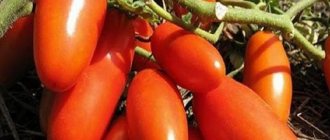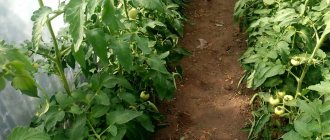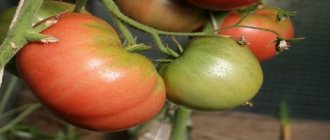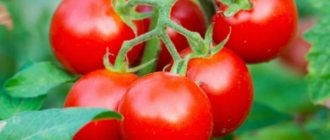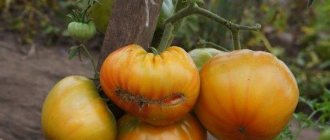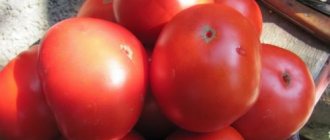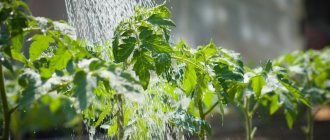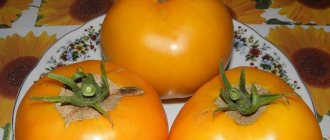Characteristics of the tomato variety Linda F1
The Linda F1 tomato cultivar was bred by Japanese breeders in 2009. It is a hybrid. When buying seeds, pay attention to the name, as there is another type of tomato called Linda , created by Russian scientists. This is a type of cherry tomato that is grown on the balcony.
Both varieties have earned a good reputation for their early maturity and yield volumes. Now let's talk in more detail about the tomato variety Linda F1.
Features of hybrid fruits
Linda F1 tomatoes are medium-sized fruits, from 80 to 150 g , the weight of some reaches 300 g. The color is juicy red. The variety is suitable for fresh use and in homemade preparations for long-term storage, including in whole form.
The shape of the fruit is slightly flattened, round, the skin is dense. The taste is rich, but unobtrusive, pleasant, slightly sour. The appearance of tomatoes is attractive and “tasty” , so for gardeners preparing the crop for sale, this will be a significant advantage.
Characteristic
Linda tomatoes have ultra-early ripening periods. This plant belongs to the determinate type and bears small cherry fruits. This variety of tomato is intended for growing indoors, so it can often be found on balconies and loggias; it also grows well in a room, on a windowsill.
Attention! It is quite possible to grow a Linda tomato in a garden bed. You just have to first sow the seeds and get seedlings from them. You can also decorate a veranda or gazebo with such miniature bushes by planting tomatoes in beautiful boxes and decorative pots.
Detailed description of the Linda variety:
- varietal type tomato, that is, the owner will be able to collect seeds from his own fruits and sow them again next season;
- the plant is of a determinate type, which means it has a terminal growth point;
- the height of the bushes rarely exceeds 25-30 cm;
- the first fruit cluster is tied after the seventh leaf;
- leaves are dark green, stems are dense;
- the bushes do not need to be tied up, they are powerful enough to support the weight of the crop;
- tomatoes are set on fruit clusters, which in their structure resemble bunches of grapes;
- the fruits are round, even and smooth, colored deep red;
- the average weight of Linda tomatoes is 25-30 grams;
- the variety's yield is high (as for cherry tomatoes) - up to three kilograms per square meter;
- The planting pattern is dense - 7-8 bushes can be grown per square meter of land;
- The tomato is resistant to fusarium, leaf spot and verticillium.
Attention! A special feature of the Linda tomato variety is their extreme unpretentiousness: the tomatoes will set well even with a lack of light, the bushes will not disappear during cold weather or drought, and they do not need constant care.
Gardeners call the Linda tomato variety tomatoes for the lazy, so this is an excellent option for beginners or very busy owners.
Small, dense tomatoes are great for pickling or pickling, they make excellent salads, sauces, red fruits look impressive and as a decoration for various dishes.
Rules for growing miniature tomatoes Linda
As has already become clear from the description, tomatoes of this variety are very easy to grow. Tomato Linda is perfect for those who live in city apartments and do not have their own plot of land. A couple of bushes of this tomato can feed a family with delicious and healthy fresh vegetables.
The stages of growing cherry tomatoes are as follows:
- At the end of March, tomato seeds are sown in the ground. If Linda is grown indoors, you can immediately sow the tomatoes in permanent containers. When tomatoes are going to be brought into the garden, you first need to grow seedlings.
- The soil for planting tomatoes should be loose and nutritious. Good drainage is essential so that excess moisture does not stagnate in the ground. The seeds are buried 1-2 cm into the soil, sprinkled with a thin layer of dry soil on top and the soil is sprayed with water.
- As soon as the first shoots appear, the tomatoes should be fed with a complex of mineral fertilizers. Tomatoes need to be fertilized at least two more times: at the stage of formation of flower ovaries and during the period of fruit laying.
- In order for the bush to develop well, you can treat it with some kind of growth stimulator for tomatoes. For example, the special composition “Vympel” is suitable.
- Tomatoes should be watered carefully; small bushes have roots close to the surface and are easy to wash. The land is irrigated as it dries out, using settled water at room temperature.
- To ensure that tomatoes have enough sunlight, pots or boxes with plants are placed on window sills or placed on balconies or loggias. As practice shows, there is no need to add extra light to Linda tomatoes - they tolerate a lack of light well, are not delayed in development and produce the same abundant harvest.
- The first fruits can be collected in early June. Usually tomatoes ripen in whole bunches. Fruiting of the Linda tomato is extended - the bushes will produce fresh tomatoes from June to the end of September.
Advice! Don't be afraid that the tomatoes will freeze - Linda is very resistant to cold. Therefore, you can safely open the doors and windows of balconies and ventilate the apartment.
Advantages and disadvantages
Linda F1 tomatoes quickly gained popularity among gardeners. This is one of the most common varieties of tomatoes grown on our plots. Why do experienced gardeners choose this species?
The undeniable advantages of the variety:
- Large fruits, approximately equal in weight and general appearance.
- Tomato variety Linda F1 is not whimsical.
- Tolerant of temperature fluctuations.
- Easily tolerates heat.
- The thick skin protects against cracking.
- It is immune to diseases such as verticillium (fungal infection, when the leaves turn yellow below, then dry out and fall off) and fusarium (dark spots appear on the leaves, followed by drying out and loss of leaves). Also, the plant is not affected by Alternaria stem blight (damage to brown stems in the form of rings) and gray leaf spot (small spots on black-brown leaves).
- High yield - about 2 kg of fruits are obtained from each bush.
- Minimal care.
- In 100 days of life, Linda produces several crops. You will taste the first fruits in mid-June, and at the end of September you will collect the last ones.
- High yields are harvested with long daylight hours and high temperatures of 22-25 C°.
Among the disadvantages of the Linda F1 tomato, according to reviews from amateur gardeners, are:
- high cost of Linda F1 seeds;
- some summer residents noted a slight plastic taste, but this is rather a subjective assessment.
The advantages of tomatoes in terms of characteristics largely outweigh the disadvantages.
Advantages and disadvantages of the variety
The Linda tomato is unpretentious to growing conditions and performs well in any type of soil. Throughout the entire fruiting period it produces beautiful, evenly shaped fruits.
pros
- resistance to elevated temperatures, which do not have a negative effect on fruit set and color;
- with a small bush size, the crop is highly productive;
- long fruiting;
- Suitable for growing for personal and commercial purposes;
- high shelf life and transportability;
- resistance to a number of diseases.
Minuses
- a culture of hybrid origin is grown only with seeds from the manufacturer.
Features of cultivation
The ideal place for growing is open ground. Tomatoes will also be comfortable in greenhouses, and the bushes will produce a good harvest. Gardeners usually plant 4 seedlings per 1 m². Young seedlings are planted after the end of frost. In warm regions, seeds are immediately sown in the ground without first growing seedlings.
Seed preparation
The preparation of seeds of this variety is similar to other types of tomatoes: exclude defective, empty and moldy seeds.
To improve growth, professionals recommend treating the seeds with growth stimulants and, to increase resistance to infections, disinfecting them with a solution of potassium permanganate in a ratio of 1 g per 1 liter of water. The seeds are kept in the solution for 20-30 minutes, after which they are washed with running water and placed in growth stimulants for 12 hours.
Planting seeds and care
The next stage after preparation is planting the seeds in seedling cups or boxes. The ideal soil is considered to be a mixture of turf soil, peat, black soil and a small amount of sand. Gravel is poured into the bottom of cups or boxes to serve as drainage. Expanded clay is also suitable here.
2 or 3 seeds are planted in cups, and one seed per 7 cm² in boxes. The plantings are covered with polyethylene and placed in a room with a temperature of at least 25°C. Water with a moderate drip method. Light is provided up to 12 hours a day. If there is not enough daylight, lamps are used.
When the seeds sprout, the plastic film is removed and the temperature is reduced to 20°C.
After the formation of 2-3 leaves, a pick is made. When the seedlings grow to 10-15 cm, they are planted in the ground.
How to care for a tomato after planting - general recommendations
Caring for tomatoes is easy. Main:
- Water regularly after sunset.
- Do not fill. Excessive moisture will lead to the death of the bush. Before the fruits appear, it is enough to water 1-2 times every two weeks.
- Feed the soil. You can plant plants between the rows that improve the composition of the soil - peas, clover, mustard.
- Weed and hill up the soil after planting.
- Tie up bushes. Although many gardeners say that the stems are strong enough and behave well without tying them up, professionals say that this must be done so that the plants do not break under the weight of the ripe crop.
- Protect from insect pests.
- To prevent diseases: spray with a solution of wood ash or nettle tincture.
Popular fertilizers
Despite the unpretentiousness of the variety, the soil needs to be fed 5 times per season with organic and mineral fertilizers:
- Before planting seedlings, gardeners fertilize the soil with manure and compost.
- 3 weeks after planting the seedlings, phosphorus, potassium and nitrogen or a solution of bird droppings are added to the soil.
- When the ovary is formed, the soil is fertilized with ready-made mineral fertilizer: “Ideal”, “Nitrophoska”, “Agricol-Vegeta”. Potassium chloride and sodium humate are also used.
- During the next feeding, when flowers form on the third cluster, mineral fertilizers are also used, including potassium sulfate and superphosphate.
- Gardeners carry out the last feeding 14 days after the previous one, mainly using superphosphate.
Planting and watering
Seedlings are planted when they reach a height of about 12 centimeters. The seedlings turn out to be miniature, the roots are watered only slightly (literally 100 - 200 milliliters of water per bush). Seedlings should not be planted deep - the root system of these tomatoes is not extensive, most of it will be visible on the surface.
It is recommended to water frequently - about once every 3 days. But Linda tomatoes tolerate even severe drought well. Optimal planting scheme in a greenhouse:
- 6 bushes per linear meter;
- row spacing - up to 50 centimeters.
Naturally, there is no need to tie the garter; side shoots (stepchildren) cannot be removed either.
Ripening time and yield
The first fruits are harvested around mid-June. If the seeds were planted in March, after about 100 days, summer residents try their tomatoes. Linda F1 bears fruit until late autumn. It is noted that the more often the fruits are removed from the bush, the more fruit it bears.
Productivity reaches 2 kg per bush. Fans also point out that all the fruits of this plant turn red quickly and at the same time, so some gardeners treat the bushes with a magnesium solution so that they do not turn red longer.
The best time to harvest is early in the morning. First, remove the ripe tomatoes. For long-term storage and sale, it is recommended to remove brown tomatoes; they will ripen on their own in a dark place.
Origin of the variety
The Linda tomato was bred by a Russian group of breeders under the leadership of Gavrish. This is one of the most famous agricultural holdings from the Russian Federation, well known outside its native country. Since 2007, this tomato variety has been added to the state register and is in demand in other CIS countries. Popular in regions where the average annual temperature does not rise above 16 degrees (regular tomatoes are almost impossible to grow there).
It is noteworthy that Linda tomatoes are actively used by foreign breeders to develop new hybrid varieties with high yields. One of these is Linda F1, which was developed by Japanese breeders in 2009. There are many more variations of varieties of ultra-short-ripening Linda tomatoes, but only these two are in demand.
Methods for obtaining seeds
According to reviews from experienced professionals, it is better not to use Linda f1 tomato seeds from last year’s harvest . Each season, new seeds are acquired, just as with other hybrids. But if you still decide to try to get seeds at home, here’s what experienced tomato growers advise you to do:
- Choose the largest, undamaged, ripe fruits. If you choose brown or pink ones, in any case, wait for them to ripen, for example, on a windowsill. The first ripened fruits are best.
- Wash the tomatoes and carefully cut them in half.
- Use a spoon to scoop out the seeds and place them in pre-sterilized jars with boiling water.
- Cover the jars with gauze and secure with a rubber band.
- At a temperature of 23-25°C, leave the seeds to ferment in their own juice for two days, no more, otherwise they will germinate.
- Remove and wash the seeds through several layers of gauze, removing any mucus.
- Remove pop-up and empty ones.
- Allow the seeds to dry for up to 7 days at a temperature of 25C°, using glassware or a cloth. You cannot use paper!
- Rub the resulting seeds between your fingers and let them dry for up to 2 days at a temperature of 35°C, for example, in the attic.
- Place the received seeds in a paper envelope and sign.
Give me tips on growing tomatoes!…
Firsova
Tomatoes grown indoors are of the same varieties as in open ground, although you can also plant special “balcony” tomatoes, which are especially decorative. Seedlings grown for 40–45 days are planted in boxes in a permanent place. Mineral fertilizers are added to the boxes along with the soil. Water the tomato less often than the cucumber, but abundantly, after which the wet soil is sprinkled with a layer of dry soil.
Evgeniy Petrov
Well, let's start with the basics. First, the tomato needs sunlight or lighting. That is, now is not the best time for tomatoes. Secondly, you need to water less often, and in room conditions without ventilation, with excess moisture, fungal diseases, for example blackleg, can develop. Among the varieties I can recommend are Balcony Miracle, Little Red Riding Hood, Boni-M, Gavrosh. The best seeds are “Northern Seed Company”!
Larisa
Minibel indoor tomato 15 pcs. Minibel indoor tomato 15 pcs. characteristics: company: Variety of vegetables price: 15.00 Availability: yes ——————————————————————————— A low-growing plant with small tasty fruits, suitable for growing indoors conditions. A great kitchen decoration. Sowing: in March-April in seedling boxes. Lightly sprinkle the seeds. Shoots appear after 14 days at t = 20-25 oC. Seedlings should be planted after 3 weeks. Moisten the soil regularly. Good lighting is necessary. After 4 weeks, plant the plants in pots with a diameter of 12-15 cm. Care: water as needed. Regular feeding. To improve pollination, shake the stems. Flowering: fruits ripen in July-August. This tomato variety is proven and was grown in winter, but it needs lighting.
Tasha
It won't grow now. Plant at the end of February in new purchased land.
- Tomato varieties in open ground
- Diseases of tomato seedlings
- Planting tomatoes in a greenhouse
- Picking tomato seedlings
- Growing tomatoes in open ground
- Early tomatoes
- When to plant tomatoes in Siberia
- Growing tomato varieties
- Varieties of tomatoes for the balcony
- How long are tomato seeds soaked?
- What varieties of tomatoes are the most productive?
- Growing tomato seedlings
- Tomato seed treatment before sowing
- How often to water tomatoes in greenhouses
- How to plant tomato seedlings correctly
- Caterpillar on tomatoes
Pick up plants after two true leaves appear
| Stage 1. Purchase of planting material Step 1. Since this is a hybrid variety, seeds must be purchased annually; they cannot be collected. Step 2: Buy seeds only from reputable stores. Avoid street stalls and markets | |
| Stage 2. Disinfection Stage 1. Prepare a not very saturated solution of potassium permanganate, as in the example in the photo. Step 2. Dip the seeds into the solution and let sit for 15 to 20 minutes. Remove and rinse immediately with water | |
| Stage 3. Treatment with a growth stimulator Stage 1. Buy a growth stimulator. Any option that is on sale will do. Step 2. Prepare the solution according to the instructions. Dip the seeds into it and wait the required time | |
| Stage 4. Sowing seeds Step 1. Select a container of the appropriate size and fill it with ready-made soil for seedlings. Step 2. Plant the seeds to a depth of 1 cm, water and place in a warm place. After germination, move it to the windowsill | |
| Stage 5. Picking Step 1. After two or more true leaves appear, plant the tomatoes in separate containers for better growth and development. Step 2. When replanting, pinch the central root. This stimulates the development of lateral processes | |
| Stage 6. Caring for seedlings Step 1. Water the plants about once a week. Spray with water from a spray bottle in the morning and evening. Step 2. Apply complex fertilizer for seedlings once every 3 weeks. Step 3. 10 days before planting, begin hardening. Open the window during the day for 3-4 hours |
Diseases and pests
Although Linda cherries are distinguished by their strong immunity to diseases of plants of the nightshade family, preventive measures to prevent fungi and viruses will not be superfluous.
It is also necessary to carefully monitor the condition of the soil and prevent it from becoming waterlogged during watering. Excess moisture can cause dangerous fungi to appear.
IMPORTANT: If plants are grown in an apartment on a windowsill, balcony or terrace, then they are not threatened by disease.
| Root rot Prevention: maintaining optimal humidity, constant weeding and loosening. Control: spraying the plant with Glyocladin solution | |
| Slugs Prevention: loosening the soil, mulching with sawdust. Control: soil treatment with a mixture of ash and red pepper, traps from small containers of beer | |
| Colorado beetle Prevention: planting early potatoes nearby. Fight: collecting beetles by hand, processing with special means |
Results
Two tomatoes with the same name turned out to be completely different. They have only one thing in common - Linda tomatoes will not cause trouble to the gardener, because they are very unpretentious.
Varietal Linda is suitable for growing indoors and will decorate balconies and verandas. Small, tasty fruits diversify your home menu and serve as a decoration for salads and other dishes.
Hybrid tomato is best grown in spacious areas, farm fields, but it is also quite suitable for a small country garden or a simple greenhouse. These fruits will delight you with their size, fleshy pulp and long shelf life.
Photo of hybrid Linda
Each gardener looks in catalogs for descriptions of tomato varieties and hybrids that are suitable for growing under existing conditions. Listen to the advice of experienced gardeners, perhaps they can make your choice easier.
| Early ripening | Mid-late | Mid-early |
| Garden Pearl | gold fish | Em Champion |
| Hurricane | Raspberry miracle | Sultan |
| Red Red | Miracle of the market | A lazy man's dream |
| Volgograd Pink | De Barao Black | New from Transnistria |
| Elena | De Barao Orange | Giant Red |
| May rose | De Barao Red | Russian soul |
| Super prize | Honey fireworks | Bullet |
If you find an error, please select a piece of text and press Ctrl+Enter.
How to sow correctly
Linda tomato is best sown in neutral, fertile and well-drained soil. The growing technology looks something like this:
Soak the seeds in a special solution that stimulates their germination. After some time, they are laid out on a plate and covered with a damp cloth. In a few days they will have small roots. This means that the seeds can be sown in the soil. It's a pretty easy process. Tomato seeds are simply laid out and covered with a layer of soil, the thickness of which should not exceed 1 cm. The container or bed is covered with plastic wrap until the first tomato shoots appear. After that it is removed
When it comes to growing tomatoes in boxes, special attention is paid to temperature conditions. Throughout the entire growth period, seedlings need to be fed with mineral fertilizers. After planting, fertilizing is carried out once every six months.
Read also: Copper sulfate for late blight: how to dilute and process tomatoes and other vegetables When growing a plant, it is worth considering some rules. So, for irrigation you should use only warm water. Also, grown seedlings need to be provided with a place without drafts.
Bush care
Caring for the Linda tomato hybrid is quite simple:
- Regularly water the plantings with warm, settled water. You should water only under the bush, avoiding moisture getting on the foliage and stem. Watering is carried out in the evening, after the sun has set. It is advisable to use a drip irrigation system;
- After the irrigation and precipitation procedure, do not forget about loosening, while simultaneously removing weeds;
- The plant also needs nutrients necessary for normal development and growth. During the season, feed 3-4 times with mineral complexes and organic matter;
- There is no need to carry out stepsoning. Basically, the first stepson is left under the flower ovary and the second immediately behind it;
- Form a bush with 1-2-3 stems;
- Since the stems are quite powerful, tying is not required;
- Carry out preventive treatments against diseases and pests.
